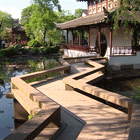Suzhou is renowned for having the most beautiful examples of classic Chinese gardens. Don looked at one of the largest, called Zhuo Zheng Yuan or Humble Administrator’s Garden. Designed in the 16th century, it makes great use of water with a maze of connected pools and islands, unlike other traditional gardens where the emphasis is on rocks. Many vistas and divided spaces open up throughout the gardens and there are many pavilions and bridges. It is considered representative of gardens in the Ming Dynasty and one of China’s four major gardens.
History
Around 1513, during the Ming Dynasty, the imperial inspector Wang Xianchen retired from public life. He returned to Suzhou and started to build a garden. He designed the five hectare garden in collaboration with the renowned Ming artist, Wen Zhengming. The original garden was fairly simple, and was far removed from the garden we see today. It consisted of ponds, trees and other ornamental plants, a few modest buildings and an area devoted to fruit and vegetables. It took 16 years to build.
The name Humble Administrator’s Garden was inspired by the essay ‘To cultivate my garden and sell my vegetable crop is the policy of humble man’. However, other references say that the garden “was named after the not-so-humble administrator, Wang Xianchen, who, upon his retirement, purchased the property with money extorted from other officials during his time at court”. According to garden scholar, Maggie Keswick, the name could also be translated to mean “Garden of the Unsuccessful Politician” or “Garden of the Stupid Officials”.
After the death of Wang Xianchen, his son gambled away the garden. It has changed hands and been rebuilt many times.
Garden design
The garden is divided into three parts – eastern, central and western. It has 48 different buildings, streams, ponds, bridges, islands of bamboo and over 700 bonsai (pinjing).
The scenery in the central area is reminiscent of that in the south of the lower Yangtze, with mountains, pavilions, artificial islands, lotus pond, bamboo, trees and flowers. Use is made of ‘borrowed landscape’ in this area. Looking westward, there is a pagoda that appears to be part of the property, but it is actually situated about one kilometre away from the garden.
The Hall of Eighteen Camellias and the Hall of the Thirty-Six Mandarin Ducks can be found in the western part of the garden. Probably the world’s most beautiful ducks, Mandarin Ducks symbolise marital happiness. Ancient furniture, paintings and calligraphies can be seen in both halls. In the ‘potted landscape garden’ or bonsai garden there is a good collection of bonsai (penjing) and other plants displayed, often on pedestals.
Throughout the garden, along the wall to the east of the lake, is a zigzagging walkway or ‘verandah’, which allows the garden to be enjoyed in all weathers.
Further information
Humble Administrator’s Garden (Zhou Zheng Yuan)
178 Dong Bei Jie, Northeast Street
Suzhou, Jiangsui Province
Opens: 7.30am – 5.30pm
Admission: Y30



